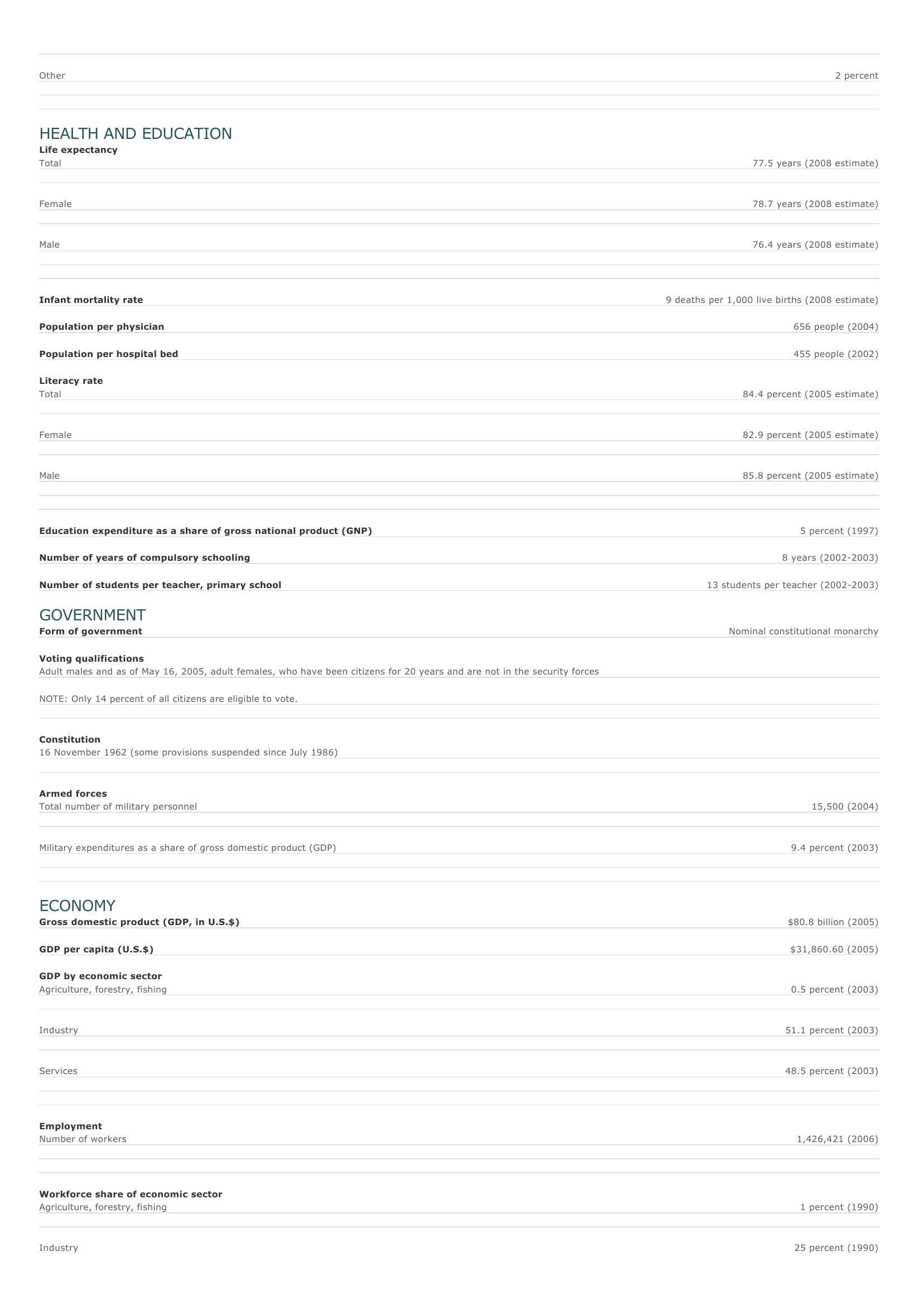Kuwait Facts and Figures. BASIC FACTS Official name Capital Area State of Kuwait Kuwait City 17,818 sq km 6,880 sq mi PEOPLE Population 2,596,799 (2008 estimate) Population growth Population growth rate 3.59 percent (2008 estimate) Projected population in 2025 4,175,172 (2025 estimate) Projected population in 2050 6,374,800 (2050 estimate) Population density Urban/rural distribution Share urban Share rural 146 persons per sq km (2008 estimate) 377 persons per sq mi (2008 estimate) 96 percent (2003 estimate) 4 percent (2003 estimate) Largest cities, with population As S? lim?yah 130,215 (1995) Jal?b ash Shuy ?kh 102,178 (1995) Hawalli Kuwait City 82,238 (1995) 1,222,000 (2003 estimate) Ethnic groups Kuwaiti 45 percent Other Arab 35 percent Indian, Pakistani 9 percent Iranian 4 percent O ther 7 percent Languages Arabic (official), English widely spoken Religious affiliations Sunni Muslim 45 percent Shia Muslim 40 percent Roman Catholic 9 percent Hindu 3 percent Nonreligious 1 percent O ther 2 percent HEALTH AND EDUCATION Life expectancy Total 77.5 years (2008 estimate) Female 78.7 years (2008 estimate) Male 76.4 years (2008 estimate) Infant mortality rate 9 deaths per 1,000 live births (2008 estimate) Population per physician 656 people (2004) Population per hospital bed 455 people (2002) Literacy rate Total 84.4 percent (2005 estimate) Female 82.9 percent (2005 estimate) Male 85.8 percent (2005 estimate) Education expenditure as a share of gross national product (GNP) Number of years of compulsory schooling Number of students per teacher, primary school 5 percent (1997) 8 years (2002-2003) 13 students per teacher (2002-2003) GOVERNMENT Form of government Nominal constitutional monarchy Voting qualifications Adult males and as of May 16, 2005, adult females, who have been citizens for 20 years and are not in the security forces NOTE: Only 14 percent of all citizens are eligible to vote. Constitution 16 November 1962 (some provisions suspended since July 1986) Armed forces Total number of military personnel Military expenditures as a share of gross domestic product (GDP) 15,500 (2004) 9.4 percent (2003) ECONOMY Gross domestic product (GDP, in U.S.$) $80.8 billion (2005) GDP per capita (U.S.$) $31,860.60 (2005) GDP by economic sector Agriculture, forestry, fishing 0.5 percent (2003) I ndustry 51.1 percent (2003) Services 48.5 percent (2003) Employment Number of workers Workforce share of economic sector Agriculture, forestry, fishing I ndustry 1,426,421 (2006) 1 percent (1990) 25 percent (1990) Services Unemployment rate 74 percent (1990) 1.7 percent (2004) National budget (U.S.$) Total revenue $46,844 million (2006) Total expenditure $23,182 million (2006) Monetary unit 1 Kuwaiti dinar (KD), consisting of 1,000 fil Major trade partners for exports Japan, South Korea, United States, Singapore, and Taiwan Major trade partners for imports United States, Germany, Japan, Saudi Arabia, and United Kingdom ENERGY, COMMUNICATIONS, AND TRANSPORTATION Electricity production Electricity from thermal sources 100 percent (2003 estimate) Electricity from hydroelectric sources 0 percent (2003 estimate) Electricity from nuclear sources 0 percent (2003 estimate) Electricity from geothermal, solar, and wind sources 0 percent (2003 estimate) Number of radios per 1,000 people 603 (1999 estimate) Number of telephones per 1,000 people 201 (2005) Number of televisions per 1,000 people 450 (2000 estimate) Number of Internet hosts per 10,000 people 11 (2003) Daily newspaper circulation per 1,000 people 376 (1996) Number of motor vehicles per 1,000 people 422 (2004) Paved road as a share of total roads 85 percent (2004) SOURCES Basic Facts and People sections Area data are from the statistical bureaus of individual countries. Population, population growth rate, and population projections are from the United States Census Bureau, International Programs Center, International Data Base (IDB) (www.census.gov). Urban and rural population data are from the Food and Agriculture Organization (FAO) of the United Nations (UN), FAOSTAT database (www.fao.org). Largest cities population data and political divisions data are from the statistical bureaus of individual countries. Ethnic divisions and religion data are largely from the latest Central Intelligence Agency (CIA) World Factbook and from various country censuses and reports. Language data are largely from the Ethnologue, Languages of the World, Summer Institute of Linguistics International (www.sil.org). Health and Education section Life expectancy and infant mortality data are from the United States Census Bureau, International Programs Center, International database (IDB) (www.census.gov). Population per physician and population per hospital bed data are from the World Health Organization (WHO) (www.who.int). Education data are from the United Nations Educational, Scientific and Cultural Organization (UNESCO) database (www.unesco.org). Government section Government, independence, legislature, constitution, highest court, and voting qualifications data are largely from various government Web sites, the latest Europa World Yearbook, and the latest Central Intelligence Agency (CIA) World Factbook. The armed forces data is from Military Balance. Economy section Gross domestic product (GDP), GDP per capita, GDP by economic sectors, employment, and national budget data are from the World Bank database (www.worldbank.org). Monetary unit, agriculture, mining, manufacturing, exports, imports, and major trade partner information is from the statistical bureaus of individual countries, latest Europa World Yearbook, and various United Nations and International Monetary Fund (IMF) publications. Energy, Communication, and Transportation section Electricity information is from the Energy Information Administration (EIA) database (www.eia.doe.gov). Radio, telephone, television, and newspaper information is from the United Nations Educational, Scientific and Cultural Organization (UNESCO) database (www.unesco.org). Internet hosts, motor vehicles, and road data are from the World Bank database (www.worldbank.org). Note Figures may not total 100 percent due to rounding. Microsoft ® Encarta ® 2009. © 1993-2008 Microsoft Corporation. All rights reserved.











